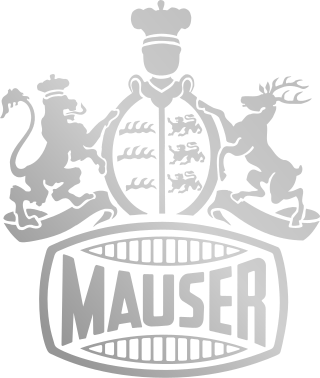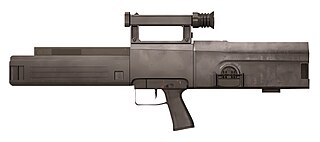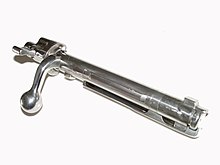
Bolt-action is a type of manual firearm action that is operated by directly manipulating the bolt via a bolt handle, which is most commonly placed on the right-hand side of the firearm.

In firearms terminology, an action is the functional mechanism of a breech-loading firearm that handles the ammunition cartridges, or the method by which that mechanism works. Actions are technically not present on muzzleloaders, as all those are single-shot firearms with a closed off breech with the powder and projectile manually loaded from the muzzle. Instead, the muzzleloader ignition mechanism is referred to as the lock.

Mauser, originally the Königlich Württembergische Gewehrfabrik, was a German arms manufacturer. Their line of bolt-action rifles and semi-automatic pistols was produced beginning in the 1870s for the German armed forces. In the late 19th and early 20th centuries, Mauser designs were also exported and licensed to many countries, which adopted them as military and civilian sporting firearms. The Gewehr 98 in particular was widely adopted and copied, and it is the foundation of many of today's sporting bolt-action rifles.

The Heckler & Koch G11 is a non-production prototype assault rifle developed from the late 1960s–1980s by Gesellschaft für Hülsenlose Gewehrsysteme (GSHG), a conglomeration of companies headed by firearm manufacturer Heckler & Koch, Dynamit Nobel, and Hensoldt Wetzlar. The rifle is noted for its use of caseless ammunition.
A repeating rifle is a single-barreled rifle capable of repeated discharges between each ammunition reload. This is typically achieved by having multiple cartridges stored in a magazine and then fed individually into the chamber by a reciprocating bolt, via either a manual or automatic action mechanism, while the act of chambering the round typically also recocks the hammer/striker for the following shot. In common usage, the term "repeating rifle" most often refers specifically to manual repeating rifles, as opposed to self-loading rifles, which use the recoil and/or blowback of the previous shot to cycle the action and load the next round, even though all self-loading firearms are technically a subcategory of repeating firearms.

A magazine, or simply called mag, is an ammunition storage and feeding device for a repeating firearm, either integral within the gun or externally attached. The magazine functions by holding several cartridges within itself and sequentially pushing each one into a position where it may be readily loaded into the barrel chamber by the firearm's moving action. The detachable magazine is sometimes colloquially referred to as a "clip", although this is technically inaccurate since a clip is actually an accessory device used to help load ammunition into a magazine or cylinder.
Blowback is a system of operation for self-loading firearms that obtains energy from the motion of the cartridge case as it is pushed to the rear by expanding gas created by the ignition of the propellant charge.
The Winchester Model 70 is a bolt-action sporting rifle. It has an iconic place in American sporting culture and has been held in high regard by shooters since it was introduced in 1936, earning the moniker "The Rifleman's Rifle". The action has some design similarities to Mauser designs and it is a development of the earlier Winchester Model 54, itself being based on a Mauser 98-type action.

The Gewehr 98 is a bolt-action rifle made by Mauser for the German Empire as its service rifle from 1898 to 1935.
A rim is an external flange that is machined, cast, molded, stamped, or pressed around the bottom of a firearms cartridge. Thus, rimmed cartridges are sometimes called "flanged" cartridges. Almost all cartridges feature an extractor or headspacing rim, in spite of the fact that some cartridges are known as "rimless cartridges". The rim may serve a number of purposes, including providing a lip for the extractor to engage, and sometimes serving to headspace the cartridge.

A bolt is the part of a repeating, breechloading firearm that blocks the rear opening (breech) of the barrel chamber while the propellant burns, and moves back and forward to facilitate loading/unloading of cartridges from the magazine. The firing pin and extractor are often integral parts of the bolt. The terms "breechblock" and "bolt" are often used interchangeably or without a clear distinction, though usually, a bolt is a type of breechblock that has a nominally circular cross-section.

In breechloading firearms, an extractor is an action component that serves to remove spent casings of previously fired cartridges from the chamber, in order to vacate the chamber for loading a fresh round of ammunition.
The Heckler & KochG41 is a German 5.56×45mm NATO assault rifle introduced in 1981 and produced in limited quantities by Heckler & Koch. It was designed to replace the 7.62×51mm NATO chambered Heckler & Koch G3 and the G3 based .223 Remington/5.56×45mm and later 5.56×45mm NATO chambered Heckler & Koch HK33 service rifles providing a more modern weapon compatible with then recently introduced NATO standards. It can use both the then new STANAG 4172 compliant 5.56×45mm NATO SS109, SS110, and SS111 ammunition and older .223 Remington/5.56×45mm M193 ammunition and was the last Heckler & Koch service rifle designed around the roller-delayed blowback mechanism.

The SIG MG 710-3 is a Swiss 7.62 mm general-purpose machine gun (GPMG) designed and manufactured by SIG - Schweizerische Industrie Gesellschaft. The weapon was developed as a commercial venture primarily for export, since the Swiss Army had already adopted the 7.5 mm MG 51 GPMG, produced by the federal arms factory W+F.
The SG 540 is a 5.56×45mm NATO assault rifle developed in the early 1970s by Schweizerische Industrie Gesellschaft of Neuhausen, Switzerland as a private venture primarily destined for export markets and as a potential replacement for the 7.5×55mm Swiss SG 510 automatic rifle known as the Stgw 57 in Swiss service.
The following are terms related to firearms and ammunition topics.

The Ruger M77 is a bolt-action rifle produced by Sturm, Ruger & Co. It was designed by Jim Sullivan during his three years with Ruger. It was designed primarily as a hunting rifle featuring a traditional Mauser K98-style two-lugged bolt with a claw extractor.
The CZ-550 is a bolt-action hunting rifle series manufactured by Česká zbrojovka Uherský Brod. The CZ 550 series is available with a medium or magnum sized action. The CZ 550 rifle is based on the Mauser 98 rifle.
The Mauser M 98 are a series of currently (2020) produced bolt-action hunting rifles. The production of the controlled round feed Mauser 98 bolt action system for the German military ceased at the end of World War II in 1945. The new Mauser M 98 and M 98 Magnum rifles for civil users are in production since 1999 in Isny im Allgäu, Germany by Mauser Jagdwaffen GmbH, according to original drawings of 1936 and the respective Mauser patents. Mauser Jagdwaffen GmbH is a subsidiary of SIG Sauer.
A firearm malfunction is the failure of a firearm to operate as intended for causes other than user error. Malfunctions range from temporary and relatively safe situations, such as a casing that did not eject, to potentially dangerous occurrences that may permanently damage the gun and cause injury or death. Improper handling of certain types of malfunctions can be very dangerous. Following gun safety rules can prevent firearm malfunctions, and limit the damage inflicted by them if they do occur. Proper cleaning and maintenance of a firearm play a big role in preventing malfunctions.










